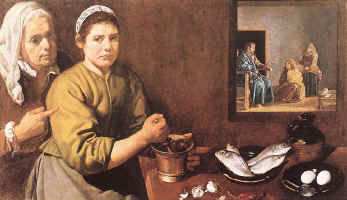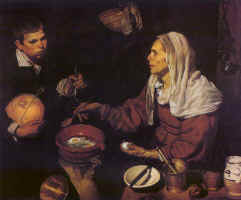|
|
|
|
|
|
|
|
|
VELÁZQUEZ, Diego
Rodriguez/ ARTISTS
BEFORE 1650/ ART MAIN
|
home |
|
(b. 1599, Sevilla, d. 1660,
Madrid)
|
film and food |
|
Velázquez was born in
Seville on June 6, 1599, the oldest of six children; both his parents
were from the minor nobility. Between 1611 and 1617 the young Velázquez
worked as an apprentice to Francisco Pacheco, a Sevillian Mannerist
painter who was also the author of an important treatise, El arte de la
pintura (The Art of Painting, 1649), and who became Velázquez’s
father-in-law. During his student years Velázquez absorbed the most
popular contemporaneous styles of painting, derived, in part, from both
Flemish and Italian realism.
Many of his earliest
paintings show a strong naturalist bias, as does The Breakfast (1617-20,
Budapest and Hermitage, Saint Petersburg), which may have been his first
work as an independent master after passing the examination of the Guild
of Saint Luke. This painting belongs to the first of three
categories—the bodegón, or kitchen piece, along with portraits and
religious scenes—into which his youthful works, executed between about
1617 and 1623, may be placed. In his kitchen pieces, a few figures are
combined with studied still-life objects, as in Water Seller of Seville
(circa 1619-20, Wellington Museum, London).
|
literature and
food
|
|
music
and food |
|
photography and food |
|
Velázquez – amazon.fr
|
|
artists before 1650 bookshop (UK) |
|
Spanish
Food
|
|
sherry |
|
sherry bodegas |
|
Diego Velazquez – amazon.co.uk |
|
Diego Velazquez – amazon.com
|
|
Breakfast
about 1617
Oil on canvas, 183 x 116 cm
The Hermitage, St. Petersburg
At an age when artists of
today are only just beginning their studies at college, Velázquez was
already painting his genre scenes: there are several studies of
musicians and peasants eating. Later, around 1625, he began to paint
scenes from the Gospels in which he found it possible to introduce
everyday objects; for instance, in his picture of Christ in the house of
Martha; he filled the foreground with a still-life of fish and eggs,
relegating the figure of Christ to the background.
In his Breakfast the human
figures are scarcely more important than the still-life. It is of course
true that the three figures reveal a thorough knowledge of anatomy,
while the details are well chosen to indicate character and personal
relationships. Superb craftsmanship is shown in the painting of the
full, parted lips of the younger man, the eyes of the old man listening
to the story and his slight movement towards the glass and the
expression on the face of the woman pouring out the wine, concentrating
lest a single drop be spilled. Nevertheless it is possible to argue that
the most striking part of the composition is the still-life arranged on
the white tablecloth. Still though these objects are, they have a
genuine pictorial quality, a vigour which is akin to life itself.
The Peasants at Table is one
of Velázquez’s finest early pieces of the type known in Spain as a "bodegón",
a combination of conversation piece and still-life. There is another
version of this painting entitled Peasant at Table in the Museum of Fine
Arts, Budapest.

Christ in the House of Mary and Martha
c. 1620
Oil on canvas, 60 x 103,5 cm
National Gallery, London
|
|
In Velasquez’s celebration of divine
drudgery, a disgruntled Martha grinds seasoning for a fish dish while
Mary adores Christ in the background. In John’s gospel, fish feature in
a eucharistic meal eaten by the risen Christ. By concentrating light and
warping perspective, the painter gives them glowing prominence.
This painting appears to show a scene
from a 17th-century kitchen. But in the upper right-hand corner there is
another scene, showing the New Testament subject of Christ in the house
of Martha and Mary. Is it is seen through a window, reflected through a
mirror, or is it a painting hanging on the wall? In all likelihood it is
a view into an adjacent room, but perhaps Velázquez deliberately left
things a little unclear because he didn’t want this part of the painting
to be taken too literally. In 17th-century Spain still-life painting was
just coming into its own, but very often paintings of food were extended
to include cooks and kitchen maids preparing it. A moral was often added
as well.
Since the younger woman looks slightly unhappy with her labour we may be
intended to think that the older woman is reminding her of how Christ
urged Martha to be content with her lot. In which case the scene top
right is a visual equivalent to the words spoken by the woman. It is
even possible that a painting of this sort was made to hang in a
kitchen.
 |
Old Woman Poaching Eggs
1618
Oil on canvas, 99 x 128 cm
National Gallery of Scotland, Edinburgh
|
|